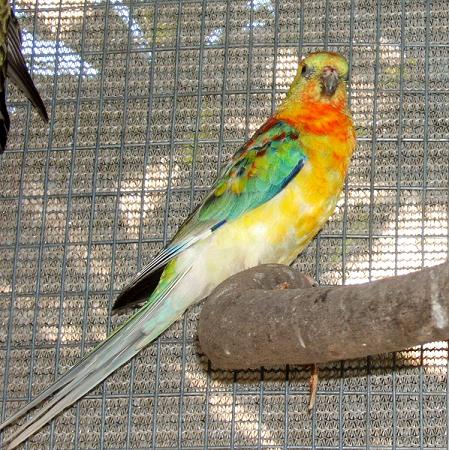

The wings are mainly blue and the shoulder yellow. The under tail coverts are white, sometimes with a little green. The back is light red with yellow undertones. The cock is mainly green with a yellow underside (with orange undertones). The species owes its name to the melodious call note. Immature birds resemble the female, young males often already have red feathers on the rump. The hens are a greyish olive green and have a grey beak.
#Mutation red rumped parrot Patch
Greenish yellow patch on the anterior wing coverts. Rump red, abdomen yellow, under tail coverts grey-white. Nape, breast, upper tail coverts light green. This just shows they can bond with people as well as each other.Ĭharacteristics: 28 cm long, Bluish Green. The ones we have in our aviary are a mated pair yet they still have become very tame with my wife Bernie. We have hand trained (tamed) these birds which like their heads scratched and will take food from you such as sunflowers seeds or vegetables etc. They are slightly larger than an English Budgie so the cage size can be the same for them, or try a Cockatiel cage. These birds can make a very good pet for beginners and the experienced person. RED-RUMPED PARAKEET (Psephotus haematonotus (Gould) In captivity, if properly cared for, these birds will live from 15 to 32 years.HAMILTON & DISTRICT BUDGERIGAR SOCIETY INC.

Red-rumped parrots can also be hand reared, provided that they have a large cage and are taken out of their cage on a daily basis to prevent boredom, as it may result in the parrot pulling out its feathers to occupy itself. They don't like to be in crowded spaces and will sometimes be aggressive towards other birds if they don't have enough space. Red-rumped parrots do well in aviaries and cages. Yellow Red rumped parrots are readily available in the market. The brooding hen is fed by her partner outside the nest.Ĭolour mutations have been bred through aviculture.

One-year-old birds are already able to breed. The eggs will hatch around 30 days after and take care to remove the chicks as soon as they are fledged or else the cock may attack his own offspring. Red rump hens will not go out of the nest box whilst on eggs and not even human checking will make them leave their eggs alone. As soon as mating has occurred the hen will deposit 4 to 7 eggs which she will brood for about 20 days. Breeders usually use peat and wood shavings as bedding for the nests, birds like to arrange the beds to their likings. Red rumps are bred easily in captivity if provided with necessary flight space and a large nesting box. They lay 3-6 white eggs, Breeding usually takes place in spring (August to January), however, in the dryer inland areas, breeding can occur at any time of year in response to rainfall. Like many parrots, red-rumped parrots nest in tree hollows or similar places, including fenceposts and stumps. They spend a great deal of time feeding on the ground, and often call to one another with an attractive chee chillip chee chillip. Their green plumage provides such a good camouflage in ankle length grasses that they can hide quite effectively until the viewer is only 10–20 metres away.

They are often seen in suburban parks and gardens. Clearing of large tracts of forest and the provision of water for stock has probably extended their range. They avoid the coast and the wetter, more heavily wooded areas. Red-rumped parrots can be found in pairs or flocks in open country with access to water. The characteristic red rump is only found in the male. The female's plumage is less vibrant, with pale olive underparts, dull green wings and back and blue-black wingtips. The male's plumage is a bright emerald-green with yellow underparts, a brick-red rump and blue highlights on the wings and upper back. Red-rumped parrots are slim, moderate-sized parrots approximately 28 cm in length. It is also known as red-backed parrot and grass parrot. The IOC has designated red-rumped parrot as its official common name. Hence all other species in the genus have been moved to the new genus Psephotellus, leaving the red-rumped parrot as the sole member in the now monotypic genus. It was long presumed to be closely related to the mulga parrot, however analysis of multiple genetic material shows it to be an early offshoot of a group containing the genera Platycercus and Barnardius. It is the type species for the genus Psephotus. Although Gould presented the new species in 26 September 1837, the account was not published until 15 February 1838 He gave it its species name on account of its red rump. He felt it was intermediate between the genera Platycercus and Nanodes, placing it in the former. The red-rumped parrot was described by John Gould in 1838 as Platycercus haematonotus from a specimen collected in New South Wales. Is one of those MUST visit pages if you're in to bird watching.


 0 kommentar(er)
0 kommentar(er)
